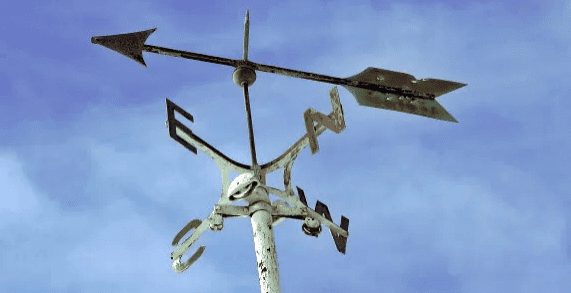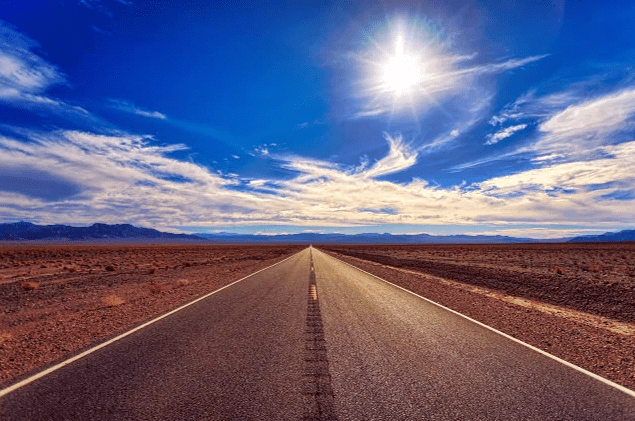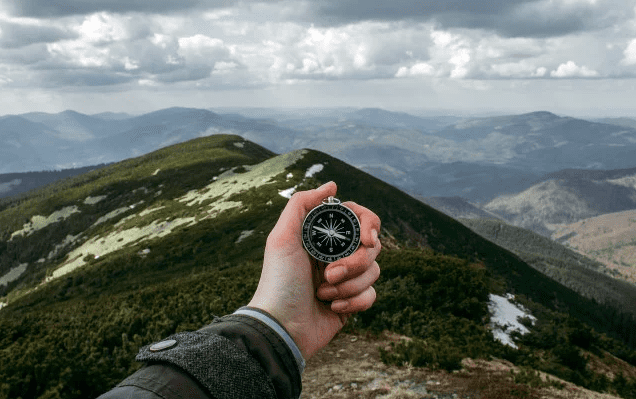If you are having trouble with this Compass or need additional Geo. data, below is a button to our other Compass.
Imagine how wonderful it would be to have the ability to navigate anywhere in the world, be it mysterious forests, unfamiliar city streets or remote corners of the planet. Our online compass is just the right tool to help you feel like a true explorer, reliably pointing the way.
Why choose our compass? First of all, it's simplicity and convenience. With a single click, you can instantly see where the sides of the world are pointing. North, south, east and west are no longer just words, but reliable reference points on your way.
The compass is ideal for adventurers and those who love to travel. Whether you are a hiker, cyclist or car traveler, it will become your indispensable companion. And for those who prefer the quiet outdoors, it opens up new possibilities for exploring the environment.
Our online compass is powered by your device's geomagnetic sensors to provide highly accurate directions. You just need to make sure that your smartphone or tablet has the necessary features enabled and that the sensors are working properly. Remember that near metal objects or near sources of electromagnetic waves, the compass may have some errors, so in such conditions it is better to use it in conjunction with other navigation methods.
Use our online compass to discover new horizons and explore the world around you with confidence and ease. Set off on your journey with a reliable compass that is always at hand and ready to point you in the right direction!
What is an online compass?
Online Compass is an innovative tool that turns your device into a navigation aid. With its user-friendly interface and visual display, this web-based tool allows you to instantly determine directions as if you were holding a real compass. Simply click on the “Launch Compass” button and you'll see an arrow pointing in the direction and a marker showing your position on a virtual picture of the world.
How to use this tool?
The online compass is easy to use and can be accessed from any device - be it a desktop computer or a cell phone. It does not require an internet connection to operate, making it an indispensable compass for traveling or expeditions to places where connectivity is limited. In addition to its basic function of showing directions, this compass helps you navigate to significant points of interest or locations you are looking for.
The benefits of an online compass!
An online compass has many advantages over traditional compasses. Firstly, it is always at your fingertips - all you need is a network connection or just a downloaded app. Secondly, you don't need to carry it with you as a separate item - it is integrated into your device. In addition, the compass is not subject to mechanical damage and is always ready to use.
Your personal orienteering assistant
Using an online compass is becoming increasingly popular among travelers, tourists and anyone looking for a convenient way to navigate in space. This tool greatly simplifies navigation and makes it accessible anywhere in the world. An online compass is a reliable and practical way to always know which direction to take, especially in unfamiliar terrain.
Why is my compass not working?
If the compass on your device is not working, there are several possible reasons and solutions:
No Geolocation:
- Why: The compass often depends on your location data provided by a geolocation service.
- Solution: Make sure geolocation is enabled on your device. In your device settings, check the permissions for the app or website that uses the compass.
Lack of Sensors:
- Why: Some devices may not have built-in compass sensors.
- Solution: Check the specifications of your device to make sure it supports a compass. If not, then unfortunately the compass will not work.
Lack of Calibration:
- Why: The compass requires calibration to accurately determine the direction.
- Solution: In most cases, the app or device should prompt you to calibrate the compass. Follow the instructions for calibration. This usually involves rotating the device in a specific order.
Weak GPS Signal:
- Why: The compass may not work properly if the GPS signal is weak.
- Solution: Try using the compass in more open areas or connect to Wi-Fi to strengthen the GPS signal.
Technical problems:
- Why: Some devices may encounter technical issues that may cause the compass to crash.
- Solution: Try restarting your device or updating the software. If the problem persists, you may need to contact the manufacturer or a service technician.
How a compass works
A compass is an instrument used for navigation and orienteering that shows direction relative to major geographic directions (or points). Typically, a diagram called a wind rose shows the north, south, east, and west directions on the compass dial as abbreviated initials. When using a compass, the rose can be aligned with the corresponding geographic directions; for example, the "N" mark on the rose indicates north.
Compasses often display angle markings in degrees in addition to (and sometimes instead of) the rose. North corresponds to 0°, and angles increase clockwise, so east is 90°, south is 180°, and west is 270°. These numbers allow the compass to show magnetic north azimuths or true north azimuths or azimuths, which are usually indicated by these designations. If the magnetic declination between magnetic north and true north by angle of latitude and angle of longitude is known, the direction of magnetic north also gives the direction of true north.
When we travel, we need to know the direction in case we get lost. To help us, we will learn about the compass and its sides of the world.
The sides of the world on a compass are NORTH, SOUTH, WEST, and EAST. They are arranged in a specific order on the compass. See image.
Using right and left depends on your direction of travel. Compass directions are unchangeable, and once you learn how to use them, they will make your journey easier. You can learn the basics of right, left, front, back and more. These concepts are the first step in learning how to describe where things are. Compass directions take it to the next level and are real tools to be used when traveling.
Here are the basics:
- north and south are opposite of each other
- East and west are opposite of each other
- Standing in a box or small space, touch its north and south sides. North can be in front of you and south can be behind you.
-Now touch the east and west sides, the west will be on your left and the east will be on your right.
-Turn in different directions and touch the different directions by saying them out loud.
Using labels or Braille symbols will help make the sides a learning tool.
Just as you memorize the multiplication table, it's important to memorize how directions relate.
-When I look north, south is behind me, west is to the left, and east is to the right.
-When I look east, west is behind me, north is to the left, and south is to the right.
-When I look south, north is behind me, east is to the left, and west is to the right.
-When I look west, east is behind me, north is to the right, and south is to the left.
Practical application:
- Orientation: Compasses are widely used for orienteering in unknown places. They help you determine which direction is north, allowing you to plot a route and not get lost.
- Traveling: When traveling, especially in mountainous areas or at sea, compasses play an important role in navigation, helping travelers and sailors determine their location and direction of travel.
- Working with cards: Compasses are used when working with maps to measure distances and determine the direction between two points on the map.
- Search and rescue operations: In extreme situations such as search and rescue missions, compasses help teams find lost people or navigate difficult to reach areas.
In general, compasses are a simple but reliable tool for determining direction and orientation in the world around us, which is widely used in various areas of life.
Identify the side of the world

Determine the cardinal directions and navigate - all kinds of technical devices help us in everyday life. Here you can find out how you can find your way without them.
Why do we need to know where north is if we know where our cell phones are? The technological sophistication of the 21st century has allowed many (survival) skills to fade away. But sometimes it happens faster than expected, and we are knee-deep in difficult situations. Here you can find out how to determine the cardinal directions without using a mobile phone or navigator.
Determining the cardinal direction using the sun

A well-known mnemonic says: “The sun rises in the east. In the south, she goes for a midday run. In the West it will die. She has never been seen in the north.
In fact, the easiest way to determine the direction of light is to look at the position of the sun.
- If the sun is behind you in the morning, you are in the east and looking west. Imagine that you are standing at number 6 on an analog clock. Then the cardinal directions are distributed clockwise. 9 - south, 12 - west, 3 - north.
- Check the position of the sun around noon. In winter, the peak of the sun occurs at 12 noon, in summer - at 13 noon. If you are now walking towards the sun, you are moving south. By the way, in the southern hemisphere the opposite is true! You go north when you go towards the sun.
- If you have an analog watch with you, you can also use it to determine cardinal directions. To do this, point the hour hand towards the sun, for example, at the 5 o'clock position. Then south is exactly halfway between 12 and 5 o'clock. If it is daylight saving time, use 13:00, i.e. the 1 o'clock position on your watch, as a reference value.
Focus on the natural environment
If the sun is not shining or it is already dark, you can also use other natural features as a guide.
- Look at the growth of plants. Typically the leaves are denser and thicker on the south side of the plant. You can also find a path around the moss in the forest. Moss grows wherever it is damp, but since there is no sun on the north side, it should be greener and wetter there.
- Use the North Star as a guide because it points north. It is easy to find if you stretch out the back axle of the Big Dipper zodiac sign five times. Polaris is particularly bright and therefore easy to see. Unfortunately, this method does not work in the southern hemisphere, since the North Star cannot be seen there.
Determine direction using a compass

You can also use a compass to determine the main direction. The arrow always shows which way is north. The compass uses the Earth's magnetic field. By the way, some smartphones already have a compass application pre-installed, which also helps you navigate.
Since the methods presented may be influenced by various factors, they are not always 100% reliable. So pay attention to the following things before you dive into uncharted territory:
- Never go alone or at least let them know where you will be staying.
- Arrange a time to report on the trip. This way others will know if you are in trouble and may need help.
- Take enough provisions with you. Make sure you have a large supply of water.
- Make sure you wear suitable clothing so you don't sweat too much during the day or get cold at night.
- When hiking, be responsible to nature - don’t leave trash behind, don’t make noise, and leave everything as it is.
Using natural features for orientation
In the natural environment there are many signs that can help in determining the cardinal directions. Some of them include:
Wind Direction: Observing wind direction can be helpful for orientation. For example, the wind often blows from west to east, so feeling the wind on your face may indicate west.
Location of Rivers and Streams: Knowing the location of nearby rivers and streams can help determine direction. Water typically flows from high ground to low ground, so the flow of a river can indicate the general direction of a drainage basin.
Grass and Tree Slope: Wind and sun can affect the growth of grass and trees. For example, trees and grass may lean toward the east due to exposure to sunlight and wind. This sign can be useful in determining the direction of west.
Shadow Location: Observing the location of shadows can help determine the position of the sun and therefore cardinal directions. For example, if you are in a hemisphere where the sun is in the south at noon, then the shadow will fall to the north.
Stargazing: The night sky can provide information about cardinal directions. For example, in the northern hemisphere, the North Star (North Star) is located approximately in the north and can serve as a guide.
It is important to remember that when using natural signs for orientation, it is necessary to take into account many factors and have certain knowledge and skills. This can be a useful addition to other methods for determining cardinal directions.
Seasonal and geographical features
Different seasons and geographic regions can have a significant impact on orientation methods. Here are some features to consider when navigating in different conditions:
Snow-covered areas: In winter conditions, snow can greatly change orientation features. The sun is lower in the sky and its position may be difficult to determine due to thick clouds or reflections from snow. In such cases, it is useful to navigate by tracks in the snow, wind direction, shape and slope of snow drifts, and also use a compass.
Deserts: Navigating in desert environments can be challenging due to the lack of visible landmarks and frequently changing terrain. The main signs to look for are the location of the sun and shade, the characteristics of the sand dunes (their shape and direction), and signs of vegetation, if present. A compass can also be a useful tool for determining direction.
Forested Areas: In forested environments, especially dense forests, solar orientation can be difficult due to dense tree canopy. It is useful to pay attention to the tendency of trees to grow in the direction of the sun (if applicable), as well as to use navigation tools such as a compass or GPS. Markings on trees or other landmarks can also help while moving.
Near water bodies: Orientation near oceans, rivers or lakes can be difficult due to the lack of obvious landmarks. It is important to pay attention to the direction of water flow, which allows you to determine the direction to larger water bodies. It is also useful to use the horizon line, especially at sea, or to navigate by the stars at night.
In each of these cases, it is important to be extremely careful and pay attention to natural signs that can help with orientation. Constant practice and experience also contribute to the development of navigation skills in different seasons and geographical conditions.
Historical and cultural aspects
Nature orientation has a rich historical and cultural heritage in different regions of the world. Different cultures developed unique methods and traditions of wayfinding that reflected their knowledge of the environment and were related to their way of life. Here are some examples:
Indians of North America: Indian tribes of North America, such as the Navajo, Hopi and others, developed complex orientation systems based on the observation of natural signs. They used landmarks such as the shape of mountains, the location of rivers and streams, and the position of the sun and stars to determine directions and routes. Signs and symbols were also used, carved into trees or rocks, to indicate paths and warn of dangers.
Bedouins in the Desert: Bedouins, a people adapted to life in desert conditions, have unique navigation skills. They determine direction using stars and shadows, use observation of animal behavior, and apply knowledge of the terrain and its features to find paths to water sources and oases. They also use the characteristics of sand dunes and other natural formations in the desert as landmarks.
Vikings: Known for their sea travel and exploration, the Vikings also developed their own methods of navigation. They used knowledge of stars, waves, seabirds and other natural signs to determine direction and locate land. They knew how to read the signs of tide and used lodestone compasses and navigational instruments such as sundials and astrolabes.
These examples are only a small part of the variety of cultural and historical approaches to wayfinding. They reflect a deep knowledge and understanding of nature, which has brought the importance of navigation skills into the daily life of different peoples. The legacy of these traditions and methods of orienteering is a valuable source of knowledge and inspiration for modern people, helping them to understand the connection with nature and develop skills for independent navigation in the natural environment.
Survival and first aid tips
When you find yourself in an emergency or lost in nature, basic survival and first aid skills can make all the difference. Here are some tips and recommendations:
Survival Skills:
- Stay calm and keep your cool. Panic will only make the situation worse.
- Find shelter from weather conditions such as rain, strong winds or snow. This could be a tent, shelter, cave, or any other suitable location.
- Provide yourself with drinking water. If you don't have access to clean water, look into methods of filtering or purifying your water.
- Know how to light a fire. The fire will provide warmth, light and the ability to cook food.
- Learn the basics of hunting, fishing and foraging in the wild. Knowing your local plants and animals can be vital.
- Know how to signal your presence. A signal mirror, whistle, signal light or signs on the ground can attract the attention of rescuers.
First aid skills:
- Learn basic first aid. Knowing how to administer CPR (direct cardiopulmonary resuscitation), control bleeding, and assist with fractures and burns can save lives.
- Take a first aid kit with you. It should contain antiseptics, bandages, plasters, analgesics and other necessary medications.
- Learn specific skills related to local hazards. For example, if you are traveling in an area with venomous snakes, learn how to recognize and administer first aid if bitten.
Supplies and Knowledge:
- Carry enough drinking water and food in case you are delayed or lost.
- Carry navigational tools such as a compass, maps or GPS device.
- Wear protective clothing and footwear appropriate for weather conditions and terrain.
- Check local rules and regulations. Some regions may have visitation restrictions or security requirements.
- Share your travel plans with someone so they know where you are and when to expect you back.
It is important to remember that each region has its own unique characteristics and dangers. Therefore, it is recommended to study the local nature, climatic conditions and traditions before starting a hike or trip. Preparation, knowledge and practice of basic survival and first aid skills are key to being safe and successful in the natural environment.
 Website with 1000 mi useful SAS tools and calculators Free online resources with 1000+ SAS tools and calculators. Our site offers a variety of services including a popup builder, widget builder, business card builder, QR code generator, link shortener with analytics, and tools for video downloading and domain name matching.
Website with 1000 mi useful SAS tools and calculators Free online resources with 1000+ SAS tools and calculators. Our site offers a variety of services including a popup builder, widget builder, business card builder, QR code generator, link shortener with analytics, and tools for video downloading and domain name matching. 
Круто, мне нравится!
Спасибо за ваш отзыв. Такие отзывы стимулируют делать еще больше и лучше!